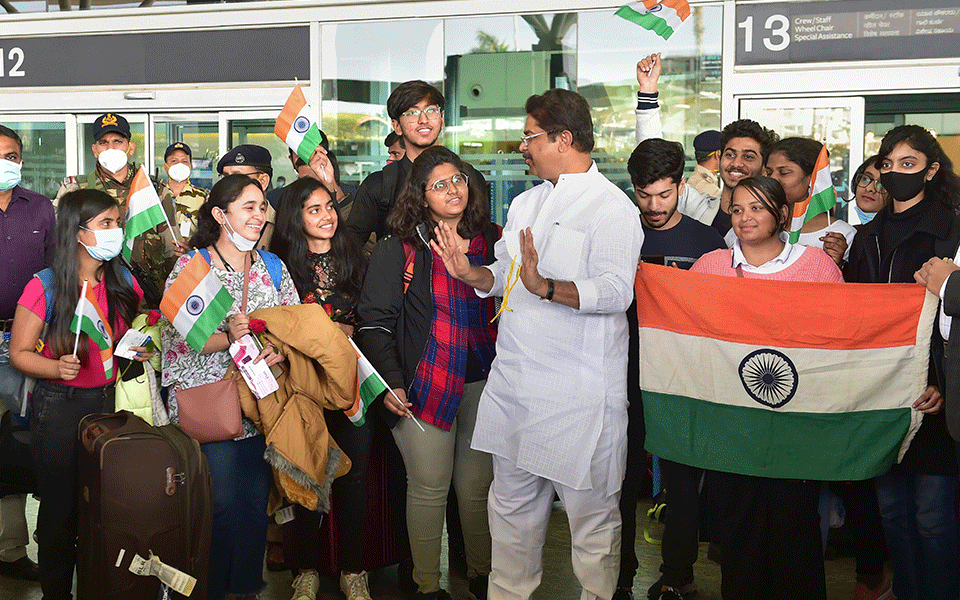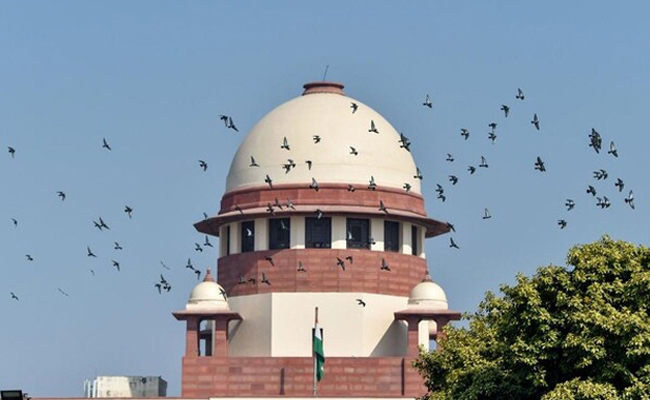Bengaluru (PTI): The Karnataka government on Sunday said around 30 students hailing from the state have been safely evacuated from war-torn Ukraine.
According to the data available with the Karnataka State Disaster Management Authority (KSDMA), based on the submissions it has received so far, about 397 people were stranded in Ukraine with 129 among them from Bengaluru.
"The Embassy of India, Kyiv, has started evacuation of stranded Indian nationals from Ukraine. The evacuation flights operating under Operation Ganga have started evacuating stranded Indian citizens in Ukraine through bordering countries, ie., Romania, Budapest, Bucharest, etc. Around 30 students hailing from Karnataka have been safely evacuated," Nodal Officer and Commissioner of KSDMA Manoj Rajan said in a statement.
The first batch of 12 students reached Bengaluru International Airport from Mumbai at 8.40 am today.
Union Minister of Parliamentary Affairs, Coal and Mines Pralhad Joshi, state Revenue Minister R Ashoka and nodal officer Rajan received the arriving students at the airport here.
According to the statement, the second batch of 13 students, and a third batch of five students hailing from the state have reached Delhi and will reach Bengaluru later tonight, it said. They have been accommodated in Karnataka Bhavan.
"Overall, 30 students will reach Bengaluru today," the statement added.
Expressing joy over her safe return, a woman student said: "They have brought us safely - Indian government, Indian Embassy, Karnataka government. They arranged flight tickets for us. Hope other students stranded in Ukraine too return safely. Though there was fear, the Embassy assured us a safe return."
Another student said, "We were evacuated through Romania border, as we were in western part of Ukraine, but don't know how authorities will evacuate those stranded in other parts like Kyiv."
Expressing worry about friends back in places like Kyiv and Kharkiv, another student said, "They are actually in crisis as they hear bombing very often and are taking shelter in bunkers. Most of them are short of basic things like food and water."
Noting that authorities are facilitating the travel of students hailing from Karnataka to their respective destinations, the statement said the local tickets from Delhi and Mumbai to Bengaluru will be borne by the state government.
The Nodal Officer and his team are in constant touch with the Ministry of External Affairs (MEA) to evacuate the remaining stranded students from Ukraine, it said.
The state government has opened a facilitation centre at Indira Gandhi International Airport, New Delhi, to coordinate and support stranded students hailing from Karnataka, who are arriving there.
Let the Truth be known. If you read VB and like VB, please be a VB Supporter and Help us deliver the Truth to one and all.
New Delhi (PTI): The Supreme Court on Monday said it will list for hearing on December 17 a plea related to worsening air pollution levels in Delhi-NCR.
A bench comprising Chief Justice Surya Kant and justices Joymalya Bagchi and Vipul M Pamcholi took note of the submissions of senior advocate Aprajita Singh, who is assisting it as an amicus curiae, that though the preventive measures are there in place but the key issue was of their poor implementation by the authorities.
Singh said till this court directs something, the authorities do not comply with the protocols which are already there.
“This is coming up before a three judges bench on Wednesday. It will come up,” the CJI said.
Another lawyer referred to an application relating to the health issue of children, and said schools, despite the earlier orders, are holding outdoor sports activities.
“Despite the order of this court, Schools have found ways and means to have these sporting activities.. it is taking place. The CAQM (Commission for Air Quality Management) is again citing the order of this court,” the amicus also said.
“We know the problem and let us pass orders which can be complied with. There are some directions which can be forcibly imposed. In these urban metropolitan cities people have their own lifestyle. But the poor…,” the CJI said.
The amicus said the poor labourers are the worst ones to suffer.
Earlier the bench had said the plea against air pollution cannot be treated as a "customary" case to be listed only during the winter months only.
It had said the case will be taken twice in a month to find out short and long-term solutions to the menace.
Delhi on Monday choked under a thick blanket of smog, with the Air Quality Index (AQI) settling at 498, which falls in the higher spectrum of 'severe' category.
The air quality was 'severe' at 38 stations while it was 'very poor' at two stations. Jahangirpuri, which recorded an AQI of 498, recorded the worst air quality amongst all 40 stations.
According to the Central Pollution Control Board, an AQI between 0 and 50 is considered 'good', 51 to 100 'satisfactory', 101 to 200 'moderate', 201 to 300 'poor', 301 to 400 'very poor', and 401 to 500 'severe'.
The AQI in Delhi had climbed to 461 on Sunday and marked the city's most polluted day this winter and the second-worst December air quality day on record, as weak winds and low temperatures trapped pollutants close to the surface.





